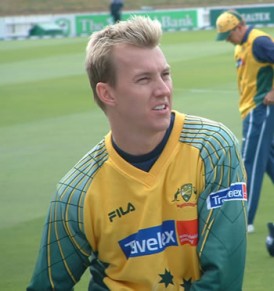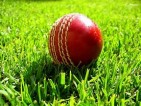A look back at Brett Lee
Marco Trevisiol |
When Australian international players have retired from first-class cricket in recent years, their careers have been relatively easy to categorise. They have either been players whose careers were full of both team and individual success (Adam Gilchrist, Matthew Hayden, Shane Warne, Glenn McGrath) or players who had the talent and potential to star on the Test scene but for various reasons invariably remained on the fringes (Darren Lehmann, Michael Bevan, Brad Hodge).
Brett Lee is a different case altogether. His Test career and statistical record is contradictory – full of both inspired moments and statistical feats but also full of underachievement and unimpressive numbers.
Just from a statistical point of view, on one hand he is one of only four Australian players to take more than 300 Test wickets. His strike rate of 53.3 is superior to modern day Australian paceman Craig McDermott and Jason Gillespie. On the other hand, his Test bowling average of 30.81 is the worst of any Australian bowler who took over 130 wickets and amongst Australia’s top 50 all-time Test wicket takers, his economy rate of 3.46 per over is the highest.
One of the reasons Lee’s Test career feels vaguely disappointing is because he started in such spectacular fashion. As impressive as his stats were in his opening 7 Tests in the 1999-2000 period (42 wickets at 16) what stood out was how much he intimidated his opponents (especially India and the West Indians). With his fast, slingy action, he had the ability to bowl vicious swinging deliveries at speeds above 150kph an hour made him a constant threat, especially with his yorkers. The way he dismantled then young batsmen VVS Laxman and Ramnaresh Sarwan with his pace and swing gave people the expectation that a great new pacemen was set to dominate Test cricket in the 2000s.
But, alas, for the most part it wasn’t to be. In fact, after returning from injury in mid-2001. for several years his performances were below par. From the start of the 2001 Ashes to the end of the 2005 ‘SuperTest, Lee played in 36 Tests, took 119 wickets at a dismal average of 39.03.
The main reason why Lee stagnated so badly in this period was that for all his pace and talent, he didn’t really utilise this with well thought out plans on how to work over quality opponents over a period of a couple of overs or even an entire spell. Too often his main thought process was to blast a batsman out with an unplayable delivery and if that did not work, try the same next delivery.
For too long his mentality was not about developing his line and length and his ‘grouping’ of deliveries, but how fast he was bowling. These comments on the 2002 tour of South Africa are typical of his public statements:
“I’m probably bowling quicker now than I ever have – consistently quicker over a long spell and I couldn’t do that six months ago. It’s a rhythm thing. A fast bowler always bowls his quickest when he’s not trying to bowl quick and that’s something Dennis Lillee has taught me. I wasn’t trying to go out there and bowl full pace. I was hitting the deck and charging in, but I was trying to work on my action as well, standing nice and tall.” (1)
Despite this poor run of form, Lee was an almost constant presence in the Test team while Steve Waugh, who was known to be a big supporter of him, was captain. An insight into this mindset is revealed in an excerpt from Jason Gillespie’s autobiography, where he talks about Damien Fleming having no chance of breaking into the side despite Lees poor form on the 2001 Ashes tour:
“There was no way he was going to get a game, because the selectors seemed to want to keep Brett Lee in regardless of anything else. Binga wasn’t bowling that well and also wasn’t taking a heap of wickets, and was going for a few runs each over. He probably need more time to be fully fit. It appeared he was still becoming match fit in the Tests, although I have my doubts about that.” (2)
For several years the selectors and Waugh treated him as a indulgence they could afford due to the team success they were having. In the end it was probably not a good thing for Lee’s development as he stagnated as a bowler during this period and it was only when he was left out for an extended period in the 2004/05 season (by now under new captain Ricky Ponting) that he seemed to show maturity in his bowling.
The 2005/06 season was a turning point as – with McGrath beginning to decline and also missing several Tests – Lee stepped up to lead the bowling attack superbly. With a new found maturity he didnt rely on pure pace or one-off unplayable ‘jaffas’ he worked over batsmen and was rewarded with an outstanding summer – in three consecutive series against the West Indies and South Africa (home and away) Lee took 64 wickets in 9 Tests at an average of 23.54. Typical of his changed bowling style was the brilliant way he wore down and eventually dismissed the great South African batsman Jaques Kallis during the 2005 Boxing Day Test through a sustained period of intense and disciplined pace bowling.
He stepped back into some old habits during the 2006/07 Ashes but the following season Lee had probably his most sustained period of high-quality cricket ever as in home series against Sri Lanka and India and a Caribbean tour. The departure of Warne and McGrath permanently from the Test side seemed to embolden Lee as he relished taking charge of an inexperienced attack. On virtually every occasion when the side needed a breakthrough, Lee delivered. He took 58 wickets at an average of just 21.55 in 9 Tests over this period and in a tribute to his consistency over this period (not a strong point for most of his career), in each of the 18 innings he took at least 2 wickets in.
After a successful tour of the Caribbean in mid-2008 it appeared that Lee had finally realised the promise he had shown right at the beginning of his career; his average had now dipped under 30 and he was closing in on 300 wickets. While he was now aged over 30, with his high fitness ethic it appeared he still had a couple of top-class years in Tests left.
But as was so often the case in his career, when a peak arrived a trough was just around the corner (or vice-versa). By the end of 2008 he had played his last Test as he suffered a dismal tour of India (he never prospered in Asian conditions) and a South Africa home series blighted by poor form and injury.
While the turnaround from world-class international bowler to a spent force within six months may appear surprising at first glance, it is less so when one considers Lee’s age and that with his bowling style relying on physical effort, exertion and stamina more than most fast bowlers that his body might start to give way.
By 2009 it was apparent that Lee’s future as a viable Test bowler was rapidly coming to a close, except to the man himself. In March of that year he was quoted as saying:
“People might think 32 is old for a bowler, but the way that I look at it, you look at the great sprinters around the world,” Lee said.
“You’re using the same type of muscles, it’s the same type of build-up, it’s all about fast-twitch fibres . . . most of those guys don’t reach their peak until they’re 34 or 35.
“I still firmly believe that I can be in the same boat as them. I actually want to get quicker and be better than what I have been.” (3)
As admirable as Lee’s self-belief was, these seemed the comments of someone unwilling to face the increasingly obvious reality that his body was not up to the demands of his highly intensive style of Test pace bowling. The abdominal and elbow injuries he suffered during 2009 were his body effectively saying enough was enough; therefore it was not a surprise when Lee announced his retirement from Test cricket earlier this year to concentrate on the less physically stressful fields of one-day and Twenty20 cricket.
So how does one assess Lee as a Test bowler? Overall he was a good player who at times bowled brilliantly and was always someone who created spectator interest and excitement with his bowling style. But there are too many holes in his record both statistically and performance-wise for him to be considered a great Test bowler, or someone who fully realised the talent and expectation at the start of his career.
But while he did not fully realise his potential he had a fine Test career who managed to play for nine years in the most successful team going around so he would not have too many complaints or regrets by the end.
And Lee’s Australian career is not finished yet with him aiming to participate in the 2011 one-day World Cup. Considering his outstanding record in that format, no one would put it past him to finish his international career on a high.
(1) Quote accessed at http://www.cricinfo.com/ci/content/story/118935.html
(2) Quote from ‘The Jason Gillespie Story’ by Jason Gillespie and Lawrie Colliver – published in 2007 by HarperSports
(3) Quote accessed at http://www.heraldsun.com.au/sport/cricket/ill-be-back-and-faster/story-e6frfg8o-1111119133827





Solid article, but missed out on the illness that Brett Lee developed on his tour of India, where he shed a great deal of weight and therefore lost pace, that he regained after returning from injury against England Lions in the Ashes tour. However, the overall theme that inconsistency and injury have plagued him and will continue too as he gets even older ring a great deal of truth about them.
Comment by Manee | 12:00am GMT 28 March 2010
My enduring memory of Brett Lee will be his spell at the end of the 2005 Ashes against Hoggard where Matthew looked like he could have played him with a stick of rhubarb despite everything including the kitchen sink being thrown at him.
I agree about the general lack of bowling intelligence. It was evident again in the IPL. He just kept on bowling half volleys looking for non-existent swing when all he needed to do was get it straight and back of a length.
Comment by Scaly piscine | 12:00am GMT 28 March 2010
You can make a lot of criticisms of Lee in tests. He did bowl poorly at times though sometimes that was due to injury, or being rushed back from injury.
But his ODI performances are outstanding. His ODI record puts him up there as one of the best ever 50 over bowlers.
Comment by slippyslip | 12:00am GMT 28 March 2010
I heard it said a number of times that people struggled to express in words why McGrath was so good. I think the case with Lee is that people stuggled to express why, for sustained periods, was he so bad.
In his physical prime is stock delivery was about 92 MPH, easily taking it up to 95-96 when he wanted to and he wasn’t famous for being overly erratic in the same way, say, Steve Harmison was/is. That said, and playing in one of the greatest sides in the history of cricket you would have thought he would have tore a new one in every team he played.
The reality was somewhat different, even mediocre batsman found that they could get through the bluff, bluster and wannabe filmstar heroics. Despite the odd vicious bouncer (often directed at feared strokemakers like Matthew Hoggard :wacko:) I was amazed at how readily milked he was by our batsman in 05. Despite memorable cameos he may have been the worst bowler in the series with the exception of the then totally blunted Jason Gillespie.
Overall, I am afraid that Brett Lee the bowler does not stand up to much scrutiny outside the ODI arena where to be fair he was very effective.
Comment by GuyFromLancs | 12:00am GMT 28 March 2010
Lee was erratic in a totally different way to Harmison. Harmison is famous for being so erratic that it’s sometimes difficult to get bat on him – there are not a few examples of Harmison spells in the longer game (in the shorter it just leads to heaps of wides) where he’s conceded a low economy-rate and routinely struggled to hit the cut strip. Lee tends to be more conventionally erratic and easily scored off.
Comment by Richard | 12:00am GMT 28 March 2010
Frustratingly he never quite reached the heights it looked like he would after McGrath’s retirement. When he got the ball reversing in the England Lions game last summer it looked like he was going to take the country by storm- but he broke down, Oz lost the Ashes and his terrifying performances in the ODIs left us with a feeling of what might have been.
He’s bowled some spells that were as good as anything I’ve seen, and always threatened to become the world-class bowler he was at the start of his career. But he never quite got there for any longer than a few series. Still, he had a fantastic mentality and especially in the last four or five years of his career I always felt that a team with Brett Lee in it was better than one without.
Comment by Uppercut | 12:00am BST 30 March 2010
i thought brett lee was a top guy loved his competitiveness and will miss him in the test arena.
Comment by lockton2skipper | 12:00am BST 30 March 2010